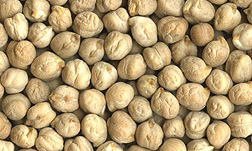
Chickpeas. Photo courtesy of
USDA/GIPSA.
|

|
Scientists Tie Chickpea Disease to Fungal Culprit
By Jan Suszkiw
August 22, 2008 The fungus Sclerotinia
trifoliorum plagues legume crops worldwide. But chickpeas seem to have
escaped its wrath, with the exception of Australia's crop. Now, that's no
longer the case, report Agricultural Research
Service (ARS) and collaborative university scientists.
During the 2005-06 chickpea growing season in central California, the team
observed stem and crown rots reminiscent of Sclerotinia infection. But
subtle irregularities in the symptoms led the researchers to believe their
prime suspect—S. sclerotiorum, which infects more 400 plant
species—had an accomplice, namely S. trifoliorum.
ARS research plant pathologist
Weidong
Chen led the team, which included Fred Muehlbauer (now retired) with the
ARS
Grain Legume Genetics Physiology Research Unit in Pullman, Wash., and
University of California-Davis
and Washington State University researchers.
They examined 10 Sclerotinia isolates from their collection from
chickpea stems and subjected each to three identification criteria: growth
rate, ascospore morphology and DNA markers indicative of S. trifoliorum.
The team's analysis showed that S. trifoliorum isolates were
slower-growing, displayed "ascospore dimorphism," which is the
formation of two versions of the same spore type, and harbored a set of group I
intron markers while S. sclerotiorum did not.
Chen suspects S. trifoliorum's occurrence on central California
chickpeas stems from prior plantings of alfalfa—another legume
host—and not an accidental introduction from Australia, the only continent
where the fungus has previously been reported on chickpea. Identification of
this new chickpea pathogen should aid in improving disease-management practices
and developing resistant chickpea cultivars for farmers.
The research is part of the ARS
National Sclerotinia Initiative. More information on this initiative is
available at:
http://www.whitemoldresearch.com
The research study was published recently in the journal Plant Disease, and is
available online at:
http://apsjournals.apsnet.org/doi/interp/10.1094/PDIS-92-6-0917
ARS is a scientific research agency of the U.S. Department of Agriculture.